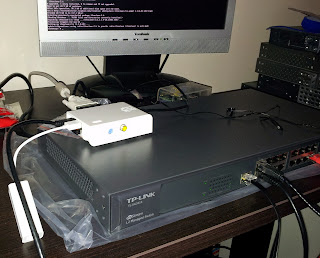Testing out Link Aggregation
I picked up a TP-Link managed switch last week as something of a compromise between affordability and features - as it turns out though, it does just about everything I could ask for, just without the extra expense from buying something that has HP or Cisco written on the side.
I grabbed the TL-SG3216, a fanless L2 managed switch with 16x1Gigabit ports as it ticked all the boxes:
- Silent (fanless)
- Managed
- Link Aggregation/802.3ad (LACP)
- 802.1Q (VLAN)
- STP
As a bonus, the CLI interface (via console cable or ssh) is very similar to Cisco's IOS, so I don't have to learn an entirely new syntax to configure it.
Before I replace my existing switch, I spent a bit of time testing out its features. First up, I setup a spare Raspberry Pi with a second ethernet interface (via a USB dongle) to test out link aggregation.
First up, the configuration on the Pi (Raspbian):
Install ifenslave to allow for the creation of bonded network interfaces
# apt-get install ifenslave
Remove lines for eth0, eth1 from `/etc/networking/interfaces` and replace with a bond0 entry that adds the two interfaces as slaves:
auto bond0
iface bond0 inet static
address 192.168.1.10
netmask 255.255.255.0
gateway 192.168.1.123
# jumbo frame support
mtu 9000
# bond settings
bond_miimon 100
bond_mode 4
bond-downdelay 200
bond-updelay 200
slaves eth0 eth1
Note on bond modes:
- mode 0 (load balancing [rr])
- mode 4 (802.3ad)
Bring up the interface:
# ifup bond0
Check its status:
# cat /proc/net/bonding/bond0
Ethernet Channel Bonding Driver: v3.7.1 (April 27, 2011)
Bonding Mode: IEEE 802.3ad Dynamic link aggregation
Transmit Hash Policy: layer2 (0)
MII Status: up
MII Polling Interval (ms): 100
Up Delay (ms): 200
Down Delay (ms): 200
802.3ad info
LACP rate: slow
Min links: 0
Aggregator selection policy (ad_select): stable
Active Aggregator Info:
Aggregator ID: 1
Number of ports: 1
Actor Key: 4
Partner Key: 1
Partner Mac Address: 00:00:00:00:00:00
Slave Interface: eth0
MII Status: up
Speed: 10 Mbps
Duplex: half
Link Failure Count: 0
Permanent HW addr: b8:27:eb:95:0e:4d
Aggregator ID: 1
Slave queue ID: 0
Slave Interface: eth1
MII Status: up
Speed: 100 Mbps
Duplex: full
Link Failure Count: 2
Permanent HW addr: 20:c9:d0:2c:93:9a
Aggregator ID: 2
Slave queue ID: 0
One strange thing from the above output is that it listed eth0 as running at 10Meg and half-duplex. However, checking both the switch and eth0 via ifconfig and dmesg shows the interface running at 100Meg/full - so I'm not sure why this discrepancy exists.
Examining each interface in turn shows the two physical adapters up and running in slave mode while the created bond0 interface is running as a master. Once bonded, all interfaces share a hardware address (that of the first interface):
# ifconfig eth0
eth0 Link encap:Ethernet HWaddr b8:27:eb:95:0e:4d
UP BROADCAST RUNNING SLAVE MULTICAST MTU:1500 Metric:1
RX packets:5466 errors:0 dropped:0 overruns:0 frame:0
TX packets:4048 errors:0 dropped:0 overruns:0 carrier:0
collisions:0 txqueuelen:1000
RX bytes:7513825 (7.1 MiB) TX bytes:358909 (350.4 KiB)
# ifconfig eth1
eth1 Link encap:Ethernet HWaddr b8:27:eb:95:0e:4d
UP BROADCAST RUNNING SLAVE MULTICAST MTU:1500 Metric:1
RX packets:68 errors:0 dropped:42 overruns:0 frame:0
TX packets:0 errors:0 dropped:0 overruns:0 carrier:0
collisions:0 txqueuelen:1000
RX bytes:7256 (7.0 KiB) TX bytes:1408 (1.3 KiB)
# ifconfig bond0
bond0 Link encap:Ethernet HWaddr b8:27:eb:95:0e:4d
inet addr:10.33.2.51 Bcast:10.33.7.255 Mask:255.255.248.0
UP BROADCAST RUNNING MASTER MULTICAST MTU:1500 Metric:1
RX packets:320 errors:0 dropped:42 overruns:0 frame:0
TX packets:129 errors:0 dropped:0 overruns:0 carrier:0
collisions:0 txqueuelen:0
RX bytes:30587 (29.8 KiB) TX bytes:19586 (19.1 KiB)
Configuration on a TP-Link TL-SG3216 switch is as follows:
Add two ports to an etherchannel group and set the mode of the channel group to `active`:
switch01(config)#interface range gigabitEthernet 1/0/1-2
switch01(config-if-range)#channel-group 1 mode active
Show the etherchannel and LACP info to check the configuration is active:
switch01#show etherchannel
Channel-group listing:
----------------------
Group: 1
----------
Group state = L2
Ports: 2 MaxPorts = 16
Protocol: LACP
switch01#show lacp 1 int
Flags: S - Device is requesting Slow LACPDUs
F - Device is requesting Fast LACPDUs
A - Device is in active mode P - Device is in passive mode
Channel group 1
LACP port Admin Oper Port Port
Port Flags State Priority Key Key Number State
Gi1/0/1 SA Up 32768 0x1 0x783 0x1 0x7d
Gi1/0/2 SA Up 32768 0x1 0x783 0x2 0x3d

Comments
Post a Comment